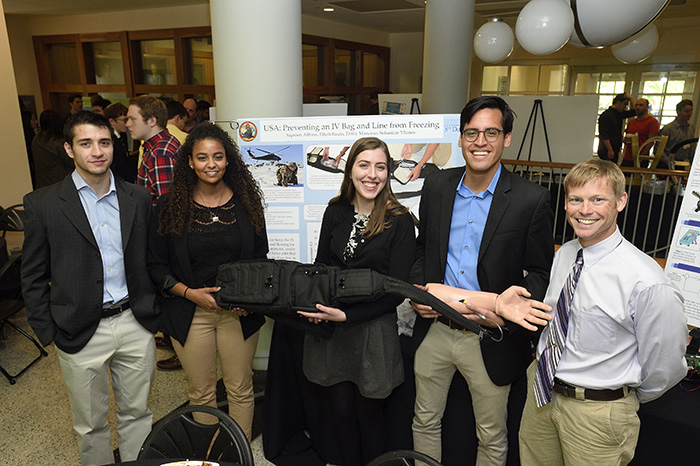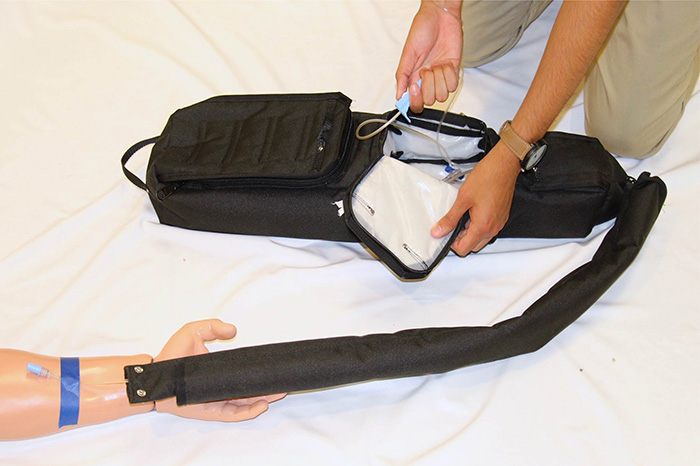USAMMDA Challenges JHU Students to Develop Prototype to Prevent IV Bag and Line from Freezing


Students in the Johns Hopkins University Mechanical Engineering Senior Design program have developed a prototype for a product to prevent an IV bag and line from freezing in the field. The project was sponsored by U.S. Army Medical Materiel Development Activity and tasked by the Medical Support Systems Project Management Office.
The product challenge was assigned to seniors Sapreen Abbass, Elijah Baum, Emily Mancuso, Sebastian Yllanes and junior Natasha Suri, who were paired with Jake Fox, MSS PMO product manager as their advisor.
Fox, along with Steven Hawbecker, MSS PMO project manager, and Maureen Milano, MSS PMO deputy project manager, came up with a few ideas for projects to address issues in the field that they thought might be interesting for the students to work on. The ideas were then presented to JHU program faculty Dr. Nathan Scott and Soraya Bailey for final selection.
The MSS PMO challenge presented to the students was to find a solution to prevent fluid in an IV bag from freezing within minutes where temperatures reach as low as minus 40 degrees Celsius. This changes the composition of the Lactated Ringer's Solution, used to keep wounded Warfighters hydrated, and the IV bag is then rendered useless. The students were required to create a prototype that keeps the IV bag above the freezing temperature at all times; keeps the catheter (a flexible tube with needle) output above 21.1 degrees Celsius in minus 40 degrees Celsius ambient conditions; and is accessible while wearing heavy gloves.
The prototype itself contains a series of chambers made from rip-stop nylon canvas lined with wool that are each sealed with waterproof zippers. It can be hung in a vertical position to allow the solution to drip down through the IV line.
"Heating the bag and line is a problem. We couldn't use a battery, because it won't work in the cold," said Baum.
To keep the solution warm, the students chose using a combination of iron powder hand warmers and a magnesium based reaction chamber. The first step in using the system is to activate the hand warmers before arriving at the scene. Once exposed to air, the hand warmers will keep the IV bag warm during transport for up to eight hours. The IV ports are now aligned with a hole in the bottom of the now-heated area, and the medic can zip up that section of the bag.
Upon arrival at the scene, the IV line is stuck into the bag and fed through its own insulating sleeve. The line is now ready to use. The final step is to heat the line by mixing water and magnesium in a 16 ounce water bottle chamber attached to the insulating sleeve. The chemical reaction will heat the line for 20 minutes at a time and can easily be repeated as needed. Applied to the opposite end of the IV line, is a thermochromic sticker which changes to a bright pink if the liquid in the line is too cold.
Fox took earlier prototypes to the 10th Mountain Division at Ft. Drum, New York and the Mountain Warfare School in Jericho, Vermont for user feedback. The students also took some design ideas to the Johns Hopkins Pediatric Transport for more testing and evaluation. As a result of the feedback, the team made changes to accommodate some of the suggestions made. The students conducted their testing of the final product in a walk-in freezer at the Prigel Family Creamery in Glen Arm, Maryland. The students also took it to the Johns Hopkins Pediatric Transport for more testing. As a result of the feedback, the team made changes to accommodate some of the suggestions made.
Maryland Institute College of Art alumna Jenn Kim lent her expertise to the team in construction of the bag. She provided input as to what was feasible in the design process with regards to meeting the needs of the project.
"We got exposure to a real-world design scenario," said Abbass, and her fellow students agree that this was their favorite part of the experience.
"We needed to learn the importance of communication – reaching out to manufacturers and talking to other people. Progress was slow until then," said Baum.
According to Fox, to complete the process, students had to create a problem statement, develop features to address those problems, test their product, and ask end-users for their opinions and feedback. They were given a budget to develop the product, which the students were able to keep within, and they learned the importance of keeping the customer up to date on all aspects of development. The students met with Fox online every two weeks to present a visual update and visited USAMMDA once in the fall.
"The steps taken by the students were the same ones we as product managers would take only they were done on a compressed timeline," said Fox.
This is the first year USAMMDA has participated in the JHU Senior Mechanical Engineering Senior Design program.













